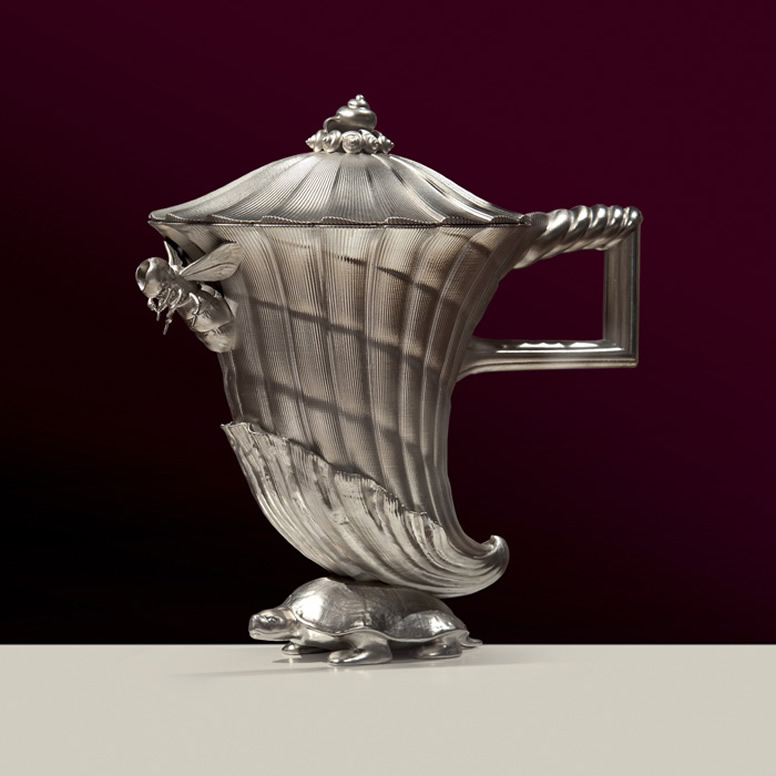The Diverse Maniere contains two diagrams showing the possible influence of shell forms upon Etruscan vase designs. Piranesi’s ambition was to revitalise design, make it relevant and, above all, to demonstrate the deeply interconnected relationship between the things people live with and their quality of life. He sought the principles of design that made natural things beautiful and was dismissive of the illustrative and decorative use of nature as an ornament, a fault he attributed to the Greeks: ‘The Greeks, by concentrating on ornamentation, on the subdivision of parts, and on carvings that have perhaps been too successful in achieving a kind of vain prettiness, at the expense of gravity. It could truthfully be said that no shrub nor tree exists from which they have not borrowed little stems or fronds to embellish their architecture; there are no apples, flowers, or animal figurines that they have not imported into their friezes; no animal skins or mouldings or caprices of any kind that have not been carved by them on pedastils or architraves. But, though all these are taken from nature, and formed as nature makes them, I still think it necessary to consider whether placing such things on cornices, friezes, or architraves is any more natural than, for example (as Horace says), painting a cypress tree in the midst of the sea when depicting a shipwreck.’ Piranesi’s interest in nature as the font of all beautiful design was revived in Germany at the end of the C19th century with the drawings and observations of Ernst Haeckel (1834–1919). Haeckel wanted to show that the evolutionary history of life results in ever more complex forms of structure and pattern. His aim was not to argue against superb design in nature, but to reveal it as the result of an evolutionary process. Haeckel’s interests proved invaluable for those who sought to naturalise the arts and, in designs from Paris Métro stations to Tiffany jewels, such aesthetics dominated fin de siècle taste. An inspection of the language of design in Piranesi’s Coffee Pot reveals a close study of how natural forms evolve. The depiction of the tortoise is simple and stylized and could be open to accusations of illustration that he levelled against the Greeks. The movement in the body of the pot from a natural shell to a stylised ridging is a movement from a direct quotation of natural form to a high level of abstraction closely based on observing the way a shell develops. The subtle movement from this language to a modern treatment in the handle almost prefigures art deco design and the roots of modernism. With small simplifications this handle seems to belong to Christopher Dresser (1834–1904). The handle sits comfortably on an object designed before 1769, which is testament to Piranesi’s taste and the fertility of his imagination. When making the coffeepot some liberties have been taken with the bee in order to produce a working spout and a modification has been made to the lid so that it stays in place when the pot is being used and to make the handle more ergonomic. Gualtieri Collection of Shells Niccolò Gualtieri (1688–1744), medical doctor, malacologist and professor at the University of Pisa, had assembled a major shell collection. He devised a system of classification which was admired by later zoologists, including Jean-Baptiste Lamarck (1744–1829). Part of his collection still exists in the Museum of Natural History and the Territory of Calci, operated under the auspices of the University of Pisa. Gualtieri co-founded the first European botany society, the Botanical Society of Florence, in 1716. For someone with a fertile imagination, the wonder cabinets and cabinets of curiosities provided an important source of inspiration. The collection of Ulisse Aldovrandi (1522–1605), described as the eighth wonder of the world, established natural history, and the stories associated with it, as an important field of study with its roots in the classical world. He was described both as the ‘Bolognese Aristotle’ and the ‘second Pliny’. For Piranesi the wonders of nature were not enough, they needed to be filtered through human perception. If he lived now he would surely respond to the shrinking divide between human and non-human, and perhaps find even greater meaning in the inspiration offered by nature and natural resources. Coffee houses Piranesi’s two designs for the Caffè Degli Inglesi in Diverse Maniere are the only record of the paintings that remain. They are presented alongside a series of designs for elaborate Egyptian-style fireplaces. Piranesi’s ‘new aesthetic’ of excessive and cross-cultural references was intended as a clear refutation of increasingly dominant but austere theories about Greek purity. Piranesi was showing them in the most important meeting place in Rome for international ‘grand tourists’. Piranesi’s Egyptian designs appear long before Napoleon and Denon’s discoveries in Egypt that triggered the C19th design fantasies of the Egyptian Revival. This coffee pot, which appears in Diverse Maniere, is an coherent example of Piranesi’s aesthetic. Coffee seemed to offer him the perfect vehicle to address the complicated issue of taste.
|

